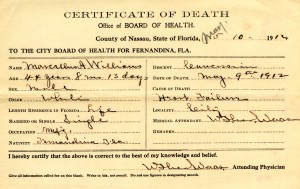When I was collecting information on Major Nathan S. Boynton’s hotel on the beach, I found many old ads for the hotel in The Tropical Sun and the Miami Metropolis, the area’s first newspapers. One of the peculiar findings was the hotel’s seemingly “magical” water for curing all sort of ailments. The ad states that the water is “unsurpassed,” a “certain cure for all kidney troubles.” It was even analyzed by a state chemist! Of course having healthful water with curative properties was a ploy used by many hotels of the time, especially in Europe. A.E. Parker, the hotel’s manager, was originally from England and may have gotten the idea from growing up across the pond. Maybe Boynton Beach should be bottling its special water.
Category Archives: History
The Other Mar Lago Beach Club

BOYNTON’S MAR LAGO
Did you know Boynton Beach once boasted its own Mar Lago Beach Club?
Much smaller and less opulent than the 1927 Palm Beach Mar-a-Lago Estate owned by Marjorie Meriwether Post (then Mrs. E.F. Hutton), the Boynton Beach Mar Lago Beach Club owned by Martha and Leon Robbins from Cleveland, Ohio opened in 1932.
Situated directly south of the South Palm Beach County (Boynton) Inlet, between the Atlantic Ocean and the Intracoastal Waterway (then called Lake Worth), the five-room hotel and adjacent cottage was staffed by a cook and a housekeeper.
The hotel had an upstairs lounge called the Miramar. During World War II, the Coast Guard used the second floor as a lookout point. The hotel was torn down in 1974 to build the county’s Ocean Inlet Park.
Mar Lago is Latin for “sea to lake.”
The Surveyor – Part 1
The year is 1871, and one of the most important surveyors in Florida history has a new contract from the Federal government, to survey all the land between Miami and St. Lucie
– that last frontier of America called South Florida. Marcellus A. Williams was born in North Carolina in 1818, and lived with his wife and nine children on Amelia Island. This story is so good that I’m going to write it as a “serial” story over the next few weeks, so that you will read glimpses from some of the first people who set eyes on this unspoiled paradise.
Stay Tuned!
Our New Website!
Our new website is now ready for its debut to the world. The goals of the website are to provide information on the Society and its meetings, presentations and activities. We will also have features on local history in the greater Boynton Beach area. If you have something to contribute, please email boyntonhistory@gmail.com and we will post your history!
Welcome to our blog!
This is the inaugural blog for our society as we embark on new adventures in bringing historical information to the public. The blog will feature original research as well as reprints from past Historical Society newsletters to provide some unique insights into the area’s history. Readers are also welcome to email ideas for stories.
Stay tuned!





